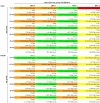Cost-effectiveness analysis of guidelines for antihypertensive care in Finland
- PMID: 17958883
- PMCID: PMC2174470
- DOI: 10.1186/1472-6963-7-172
Cost-effectiveness analysis of guidelines for antihypertensive care in Finland
Abstract
Background: Hypertension is one of the major causes of disease burden affecting the Finnish population. Over the last decade, evidence-based care has emerged to complement other approaches to antihypertensive care, often without health economic assessment of its costs and effects. This study looks at the extent to which changes proposed by the 2002 Finnish evidence-based Current Care Guidelines concerning the prevention, diagnosis, and treatment of hypertension (the ACCG scenario) can be considered cost-effective when compared to modelled prior clinical practice (the PCP scenario).
Methods: A decision analytic model compares the ACCG and PCP scenarios using information synthesised from a set of national registers covering prescription drug reimbursements, morbidity, and mortality with data from two national surveys concerning health and functional capacity. Statistical methods are used to estimate model parameters from Finnish data. We model the potential impact of the different treatment strategies under the ACCG and PCP scenarios, such as lifestyle counselling and drug therapy, for subgroups stratified by age, gender, and blood pressure. The model provides estimates of the differences in major health-related outcomes in the form of life-years and costs as calculated from a 'public health care system' perspective. Cost-effectiveness analysis results are presented for subgroups and for the target population as a whole.
Results: The impact of the use of the ACCG scenario in subgroups (aged 40-80) without concomitant cardiovascular and related diseases is mainly positive. Generally, costs and life-years decrease in unison in the lowest blood pressure group, while in the highest blood pressure group costs and life-years increase together and in the other groups the ACCG scenario is less expensive and produces more life-years. When the costs and effects for subgroups are combined using standard decision analytic aggregation methods, the ACCG scenario is cost-saving and more effective.
Conclusion: The ACCG scenario is likely to reduce costs and increase life-years compared to the PCP scenario in many subgroups. If the estimated trade-offs between the subgroups in terms of outcomes and costs are acceptable to decision-makers, then widespread implementation of the ACCG scenario is expected to reduce overall costs and be accompanied by positive outcomes overall.
Figures




Similar articles
-
The Cost-Effectiveness of Low-Cost Essential Antihypertensive Medicines for Hypertension Control in China: A Modelling Study.PLoS Med. 2015 Aug 4;12(8):e1001860. doi: 10.1371/journal.pmed.1001860. eCollection 2015 Aug. PLoS Med. 2015. PMID: 26241895 Free PMC article.
-
Comparative Cost-Effectiveness of Conservative or Intensive Blood Pressure Treatment Guidelines in Adults Aged 35-74 Years: The Cardiovascular Disease Policy Model.Hypertension. 2016 Jul;68(1):88-96. doi: 10.1161/HYPERTENSIONAHA.115.06814. Epub 2016 May 15. Hypertension. 2016. PMID: 27181996 Free PMC article.
-
Cost-effectiveness of hypertension therapy according to 2014 guidelines.N Engl J Med. 2015 Jan 29;372(5):447-55. doi: 10.1056/NEJMsa1406751. N Engl J Med. 2015. PMID: 25629742 Free PMC article.
-
[Cost-effectiveness analysis of schizophrenic patient care settings: impact of an atypical antipsychotic under long-acting injection formulation].Encephale. 2005 Mar-Apr;31(2):235-46. doi: 10.1016/s0013-7006(05)82390-5. Encephale. 2005. PMID: 15959450 Review. French.
-
Which elderly patients should be considered for anti-hypertensive treatment? An evidence-based approach.J Hum Hypertens. 1998 Sep;12(9):607-13. doi: 10.1038/sj.jhh.1000674. J Hum Hypertens. 1998. PMID: 9783489 Review.
Cited by
-
Economic evaluation of lifestyle interventions for preventing diabetes and cardiovascular diseases.Int J Environ Res Public Health. 2010 Aug;7(8):3150-95. doi: 10.3390/ijerph7083150. Epub 2010 Aug 9. Int J Environ Res Public Health. 2010. PMID: 20948954 Free PMC article. Review.
-
A systematic review of whole disease models for informing healthcare resource allocation decisions.PLoS One. 2023 Sep 14;18(9):e0291366. doi: 10.1371/journal.pone.0291366. eCollection 2023. PLoS One. 2023. PMID: 37708188 Free PMC article.
-
Cost-effectiveness of a hypertension control intervention in three community health centers in China.J Prim Care Community Health. 2013 Jul 1;4(3):195-201. doi: 10.1177/2150131912470459. Epub 2013 Jan 7. J Prim Care Community Health. 2013. PMID: 23799707 Free PMC article. Clinical Trial.
References
Publication types
MeSH terms
Substances
LinkOut - more resources
Full Text Sources
Medical

